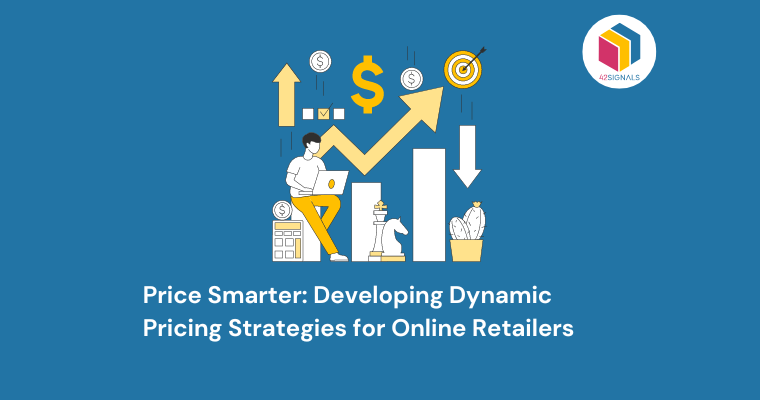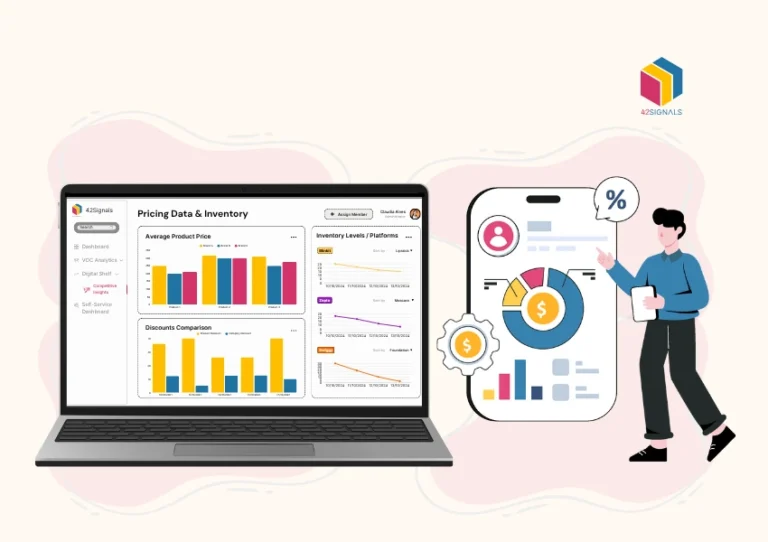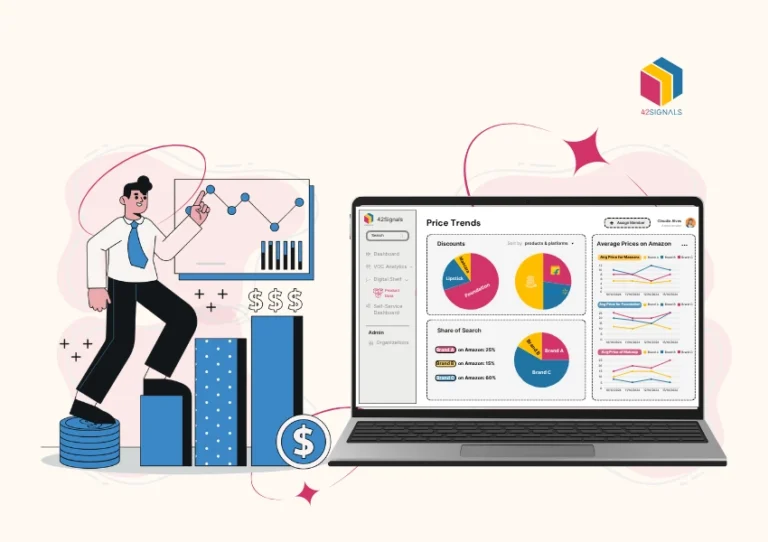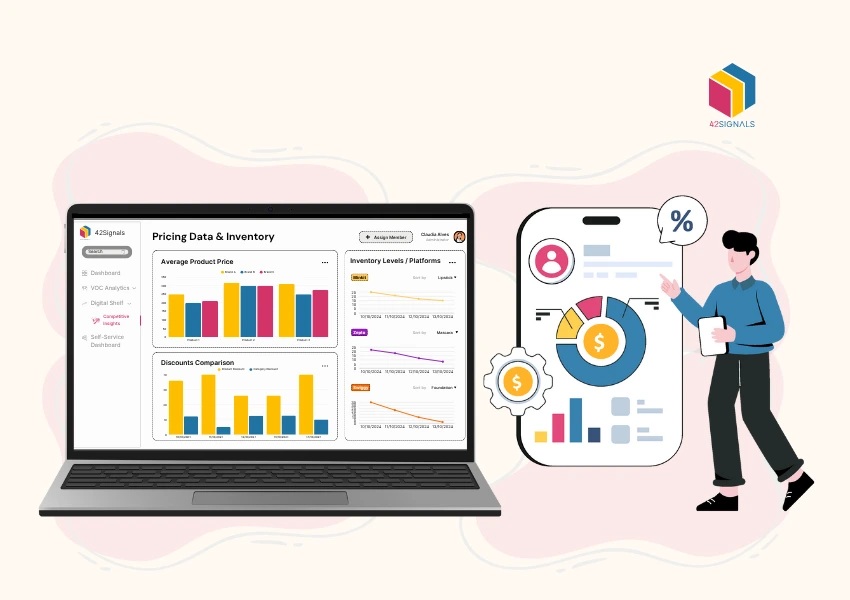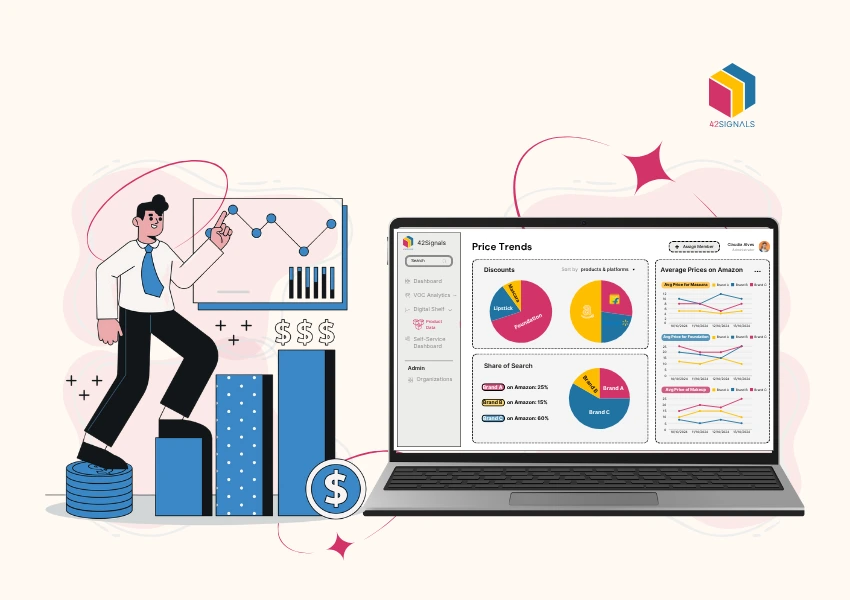Table of Contents
ToggleAs a retail business owner, boosting profitability is always a priority. In an industry with slim profit margins, the search for effective pricing strategies never ends. While fixed pricing is the norm, savvy retailers are turning to dynamic and smart pricing. Statista reports that 21% of eCommerce companies in North America and Europe have already embraced dynamic pricing. This strategy allows you to align pricing with your evolving business goals, providing you with the flexibility needed to grow revenue and boost profits.
What are Dynamic Pricing Strategies

Source: https://fitsmallbusiness.com/what-is-dynamic-pricing/
Dynamic pricing – altering a product’s price in response to changing market conditions — is extremely important to ecommerce businesses, which have a definite advantage over brick-and-mortar competitors.
The ability to automatically change pricing ensures that returns on investment are kept high and customers shopping for the best price are attracted.
It’s quickly becoming a differentiator for companies that do it right. The biggest online retailers and sales platforms, including Amazon, are already doing it for price management, giving them an advantage over in-store competition.
It may be the right pricing method for your company as well.
Dynamic Pricing vs. Traditional Pricing in Ecommerce
Dynamic pricing is a flexible strategy that adjusts prices in real-time based on market demand, competition, and other variables, contrasting sharply with traditional pricing, which tends to be static and changes infrequently. In the realm of e-commerce, dynamic pricing offers significant advantages by enabling retailers to respond instantly to market conditions.
For example, consider Amazon, a pioneer of dynamic pricing. They adjust prices on millions of products throughout the day based on algorithms that take into account competitor pricing, supply levels, and customer demand. This approach allows Amazon to optimize its pricing strategy for every product in real-time, often leading to increased sales and customer satisfaction. In contrast, traditional pricing methods might see a retailer setting a fixed price for the season, potentially missing out on revenue during peak demand or failing to clear stock when demand wanes.
Dynamic pricing’s adaptability makes it especially suitable for the fast-paced, ever-changing online marketplace, where being able to quickly adjust to the environment can be a key factor in a business’s success.
Key Factors That Influence Product Pricing Strategies

Source: https://www.geeksforgeeks.org/pricing-objectives-importance-factors-and-pricing-strategies/
Market Demand
Consumer demand is a primary driver of dynamic pricing. Online retailers can use sophisticated data analytics to track changes in consumer behavior and preferences in real time. For instance, during high-demand periods like holidays or special events, prices may be adjusted upward to maximize profits, while during slower periods, prices might be lowered to attract more customers. The ability to swiftly adapt to these fluctuations not only helps in optimizing revenue but also in maintaining a competitive edge by responding to market demand with agility.
- Real-Time Analytics and AI: Modern e-commerce platforms leverage sophisticated AI algorithms that go beyond tracking simple sales data. They analyze web traffic, click-through rates, cart abandonment rates, and even social media trends to predict demand surges before they fully materialize. For instance, if a celebrity is spotted using a specific product, algorithms can detect the rising online chatter and search volume, allowing retailers to adjust prices upward in anticipation of increased demand.
- Price Elasticity: Understanding the price elasticity of demand for your product category is crucial. Essential goods or unique products with no substitutes (inelastic demand) can tolerate smaller price increases without significantly impacting sales volume. Conversely, for highly competitive, non-essential items (elastic demand), even a small price change can lead to a large shift in demand. Dynamic pricing models must be calibrated based on this elasticity to maximize revenue without losing customers.
- Seasonality and Events: Demand is rarely static. Holidays (Diwali, Christmas), seasonal changes (monsoon, summer), and cultural events (big cricket matches, festivals) create predictable peaks. Effective dynamic pricing involves building historical models to anticipate these peaks and troughs, ensuring prices are optimized for both revenue during high demand and volume during low demand.
Competitor Pricing
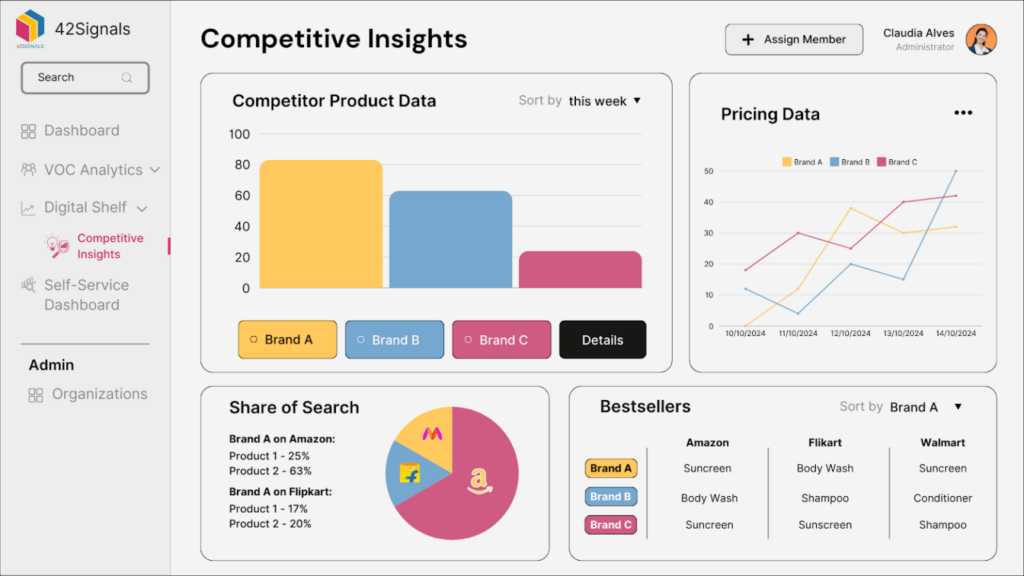
Keeping an eye on competitor pricing is crucial for any dynamic pricing strategy. Online retailers must continuously monitor how competitors price similar products and adjust their prices accordingly to ensure they remain attractive to consumers.
- Beyond Undercutting: While competing on price is common, it’s not the only strategy. Monitoring competitors allows for strategic alignment. A brand positioning itself as a premium option may intentionally price its products at or above a market leader to reinforce perceptions of quality and value. Conversely, a value-based brand might focus on ensuring its price is always a certain percentage below key competitors.
- Value-Added Differentiation: The response to competitor pricing isn’t always a direct price change. If a competitor lowers their price, a savvy retailer might instead highlight their superior value proposition: free and faster shipping, a longer warranty, bundled accessories, or exceptional customer service. This shifts the conversation from price to overall value, protecting margins.
- The Role of Technology: Automated competitor price tracking tools are indispensable. They provide real-time dashboards and alerts, not just on listing prices, but on shipping costs, coupon availability, and stock levels across multiple competitor websites. This enables retailers to make informed, strategic decisions in minutes, not days.
Supply Constraints
Supply constraints can significantly impact pricing decisions, particularly for products that are rare, seasonal, or have inconsistent availability. For example, an unexpected shortage in a popular product can lead to price increases, capitalizing on the scarcity to drive higher profits.
Conversely, retailers might lower prices to quickly move excess stock that exceeds demand. Understanding and predicting supply levels through inventory management systems and supply chain analytics allows retailers to adjust their pricing strategies proactively, preventing potential sales loss and optimizing inventory turnover.
- Scarcity and Perceived Value: Limited edition items, products with rare components, or those affected by global supply chain disruptions can command a higher price due to their scarcity. This isn’t just about maximizing profit on the item itself; it can also create a “halo effect,” drawing customers to the store for the chance to buy something exclusive, where they may also purchase other items.
- Inventory Clearance: On the flip side, pricing is the primary tool for clearing out excess or obsolete inventory. Slow-moving stock ties up capital and warehouse space. Strategic discounting, flash sales, or bundling these products with popular ones can free up resources and improve overall inventory health and cash flow.
- Proactive Supply Chain Management: Advanced inventory systems integrate with pricing software. If a best-selling item’s stock levels are dropping faster than anticipated, the system can automatically trigger a slight price increase to slow down sales velocity and avoid stockouts. Conversely, if warehouse levels are high, it can trigger promotions to accelerate sales.
Cost Structures
While customer-centric, every pricing strategy must ultimately cover costs and ensure profitability.
- Understanding COGS: The Cost of Goods Sold (COGS)—including manufacturing, raw materials, and labor—sets the absolute floor for your price. A successful price must exceed this cost.
- Incorporating Overheads: The price must also contribute to fixed overhead costs like rent, utilities, software subscriptions, and marketing. Activity-based costing helps allocate these overheads accurately to individual products to understand their true profitability.
- Lifetime Value (LTV) vs. Acquisition Cost (CAC): Sometimes, a business may strategically price a product very low (even at a loss) as a “loss leader.” The goal is to acquire a new customer at a low cost, knowing that the long-term value of that customer—through repeat purchases of other, higher-margin products—will far exceed the initial loss.
Dynamic Pricing Strategies to Consider for Your Retail Business
Dynamic pricing is a versatile strategy that allows retailers to adapt prices based on various factors, enhancing profitability and market responsiveness. Here are several dynamic pricing approaches that you might consider to optimize revenue in your retail business:
Time-Based Dynamic Pricing
This strategy adjusts prices according to specific times – whether it’s the hour of the day, days of the week, or seasons. Implementing time-based dynamic pricing could mean launching limited-time flash sales during typically slow periods to boost traffic and conversions. Seasonal adjustments are also common, such as increasing prices for winter clothing as demand peaks in the colder months, and then gradually reducing them as the season ends.
Additionally, time-of-service pricing can be applied, where prices vary based on the delivery urgency—charging premiums for same-day deliveries, while offering lower rates for standard shipping options. This method not only maximizes sales during high-demand periods but also smooths out revenue dips by enticing purchases during off-peak times.
Segment-Based Pricing Strategies
This pricing model involves setting different prices for distinct customer segments based on criteria such as demographics, geographic location, or purchase history.
For instance, a loyalty program could offer special discounts to frequent shoppers, enhancing customer retention and encouraging more consistent sales. Geographical pricing can be employed to adjust prices in different regions to reflect varying levels of purchasing power or market conditions.
Personalized pricing takes this a step further by leveraging customer data to offer bespoke discounts and recommendations, ensuring that promotions are highly relevant to each shopper’s preferences and behaviors. This approach not only increases the effectiveness of promotions but also significantly boosts customer satisfaction and engagement.
Demand-Based Pricing Strategy

Image Source: Scale Crush
Demand-based pricing strategy is a highly adaptive strategy that allows retailers to modify prices based on the fluctuating demand for products or services. This approach aligns pricing with current market conditions, maximizing profits during high-demand periods and increasing sales when demand wanes.
For instance, consider a scenario where a particular style of sneakers becomes a viral sensation on social media. As demand spikes, the inventory levels may begin to drop rapidly. In response, retailers can implement a demand-based pricing strategy to increase the price of these sneakers, capitalizing on their current popularity and the customers’ willingness to pay more. This not only maximizes revenue during the peak of its demand but also helps manage inventory more effectively, preventing stockouts.
Conversely, if the demand for a product decreases—perhaps an item is no longer in season or has fallen out of fashion – retailers can reduce prices to stimulate sales and clear out excess inventory. This aspect of demand-based pricing is particularly useful for items with seasonal sensitivity, such as fashion apparel, where trends can shift quickly.
In Summary of the Dynamic Pricing Strategy
A dynamic pricing strategy is sound for companies operating in volatile markets. Dynamic pricing will contribute to maximizing revenue, optimizing inventory, reacting to competition, and optimizing e-commerce pricing.
For some, it’s a good way to maximize revenues and meet business goals. For others, it’s a key part of staying competitive. For e-commerce analytics solutions, get in touch with us at sales@42signals.com
Frequently Asked Questions
What are the 5 most common pricing strategies?
The five most common pricing strategies used by businesses are:
- Cost-Plus Pricing – Setting prices by adding a fixed percentage markup to the product’s cost.
- Competitive Pricing – Setting prices based on competitor pricing to stay relevant in the market.
- Value-Based Pricing – Pricing based on the perceived value to customers rather than production cost.
- Penetration Pricing – Introducing a product at a lower price to attract customers and gain market share.
- Price Skimming – Setting a high initial price and lowering it over time as competition increases.
What are the 3 major approaches to pricing strategy?
Businesses typically use one of the following three approaches:
- Cost-Based Pricing – Prices are determined by calculating total costs and adding a profit margin.
- Value-Based Pricing – Prices are based on how much the customer perceives the product’s value.
- Competition-Based Pricing – Prices are set relative to competitors’ pricing in the market.
What is a pricing strategy with an example?
A pricing strategy is a method businesses use to set product prices to maximize sales and profits.
Example:
- Penetration Pricing: When Spotify launched, it offered free trials and low-cost subscription plans to attract users before gradually increasing prices.
- Price Skimming: Apple launches new iPhones at high prices and later reduces the price when new models come out.
What are the 5 C’s of pricing?
The 5 C’s of Pricing help businesses determine optimal pricing strategies:
- Cost – Ensuring price covers production, distribution, and overhead.
- Customers – Understanding customer demand and willingness to pay.
- Competition – Analyzing competitor pricing and positioning.
- Channel Members – Considering pricing impact on distributors and retailers.
- Company Objectives – Aligning pricing with business goals (profitability, growth, market share).
Which pricing strategy is best for e-commerce?
- Dynamic Pricing – Adjusting prices based on demand, competition, and inventory (used by Amazon).
- Bundle Pricing – Offering multiple products at a discounted rate to increase perceived value.
- Freemium Pricing – Providing a free basic version with paid premium features (used by SaaS businesses).
How do businesses choose the right pricing strategy?
- Consider cost structure and profit margins.
- Analyze customer demand and purchasing behavior.
- Evaluate competitor pricing and market trends.
- Align pricing with business goals (market penetration, brand positioning).
